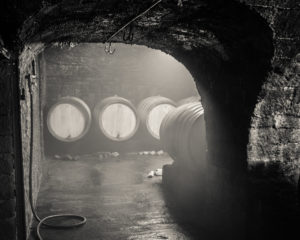German Grosses Gewächs (GG) Riesling – Power, Purity and Presence
Few grapes can match the versatility of Riesling – thus it is often dubbed “King of Grapes” and “World’s Greatest Grape”. My own journey into wine I approach it in the same way as Burgundy – Estate / Village / Vineyard. That solves a majority of the questions. The wine above, for example is made by Max Ferdinand Richter estate, grown in the vineyards of the village of Wehlen and in the vineyard called Sonnenuhr (sundial). Now comes the last part – Kabinett. This is a reference to the Prädikat system, which was created to provide further information to the consumer on the style of wine in the bottle. Kabinett refers to the lightest of the Prädikat wines, usually made in an off-dry style (unless otherwise noted). The “sweeter”, off-dry style, formalized in the 1971 wine law which put the Prädikat scale into place, came into prominence in the early 20th century, If one had to place these wines within the “modern” parameters – words like “feinherb”, “halbtrocken” would come to mind…but they wouldn’t really tell the story. The Prädikat system classifies Kabinett “feinherb” as 18 to 30 grams of residual sugar. What about the 9 to 18 grams? (GG must have 9 grams or less – but we will deal with that in a bit). These wines do exist – often producers give them a name that reflects the nature of the wine, which skirts the need to specify origin and thus avoids issues with the law. However, this article is not about the off-dry wines, as much as I personally love them, it is about the powerful, dry wines called “Grösses Gewachs” – Grand Cru wines of Germany.
However, truly sweet wines were not at all en vogue. In the earlier days, Tokaj was the wine of kings and Champagne was palpably sweet; Port and sherry, too, had their moments. Yet, in the modern world, the lighter, fresher food called for fresher, brighter expressions of the wines. Burgundy, with its steely Chablis, and brilliant Montrachet and Mersault became the symbol of success. California too, pitched in, with voluptuous (if sometimes heavy) chardonnays, bringing intensity and power, but without the pronounced sweetness and softness of the off-dry Rieslings. The VDP (Verband Deutscher Prädikatsweingüter), an association of Germany’s premier wineries and estates, created the Grosses Gewächs designation in 2002 as part of their effort to realign the position of German wines on the world market. The goal was to focus on terroir, and on quality; any wine labeled GG had to be a premium expression of the vineyard, to be a representation of a “Grand Cru”. Yet, these were not wines created out of thin air and based in stylistic expressions of other grapes. While rare, great Auslese trocken (dry) were Frankly, I was not an immediate fan of the style or the wines. I was unsure of how they would age, and many of the earlier examples felt like they were trying too hard. The best early GGs came from the slightly warmer vineyards of Pfalz and Rheinhessen (wines of Keller and Wittmann come to mind). The wines there were already more power-forward, often layering pineapple and grapefruit over the lighter orchard fruit. The dry expressions presented these notes in spades, underlining the mineral notes with broader palate and zestier citrus. Nevertheless, there were many wines that felt off-balance, struggling with the higher alcohol, seemingly giving up the sweet, ethereal naiveté of cherubs for the tight suits and close shaves of the boardroom. This was especially apparent in early Grosses Gewächs from the Mosel, where wines are even more ethereal, more orchard-fruit-driven and mineral-forward. As a longtime fan of Mosel Riesling, I was very skeptical – where will these wines go? How will they age? The VDP reassessed the classification in 2006 and in 2012, trying to bring clarity to the categories and the winemakers, too, have dialed in their wines accordingly. In fact, from the wines that I tasted for this article, majority came in at 12.5% alcohol and a few were at 13%. I even purposely re-tasted them at slightly warmer temperatures, just to see if the alcohol begins to show, and I must say I was positively surprised. Other than a few hints of warmth on the finish, the wines showed brightness and refreshing qualities even when warmer than usual.
Our trip, in the Fall of 2017, began in Nahe, with Helmut Dönnhoff and Frank Schönleber. I have had their dry wines before, but never in such depth.
My earlier worries were clearly being resolved – the alcohol was in check, the acidity as well (obviously in 2016 – but also in the several 2015s that we tried). The wines were clear, bright and utterly delicious. Obviously, the dry wines of Steinmetz, Immich-Batterieberg and Martin Muellen were wonderful – but that was no surprise. But when we tasted Florian Lauer’s wines, the wines at Von Schubert, Schloss Lieser, where I expected to stick to the Spätlese (well, and feinherb), I had to stop at the dry wines and reassess; they were really good! More than that, they represented what I always saw as the heart of Mosel Riesling – orchard-centered fruit, with a filigree of mineral and herbal notes. Mosel wines, for me, are the wines of meditative quality. They bring peace of mind, and I was afraid that the brasher, polished style of GG would obliterate that quality; I was, thankfully, wrong. They were just as peaceful, if a bit more buttoned up, but give them a chance to relax, a few years in the bottle will do. After the trip, my interest grew and I started trying more dry Rieslings from Germany. More wines from Pfalz and Rheinhessen, wines from Rheingau Mosel – Saar – Ruwer2016 Peter Lauer Feils Riesling Faß 13 Großes Gewächs: Feils is a steep, narrow, southeast facing vineyard between the Saar River and the Saar Canal. It is a warm site, with soils composed of river sediments and rubble. I first had this wine exact wine with Florian Lauer at the winery – right on release. It was already very good but tight and in need of air. Now, two years later, the wine is ready to shine, though still very young and showed much better a few days after opening than on the first night. This is a mineral-driven wine, with slate, lemon and a hint of yellow grapefruit and a touch of passion fruit and mango on the nose. The palate is very bright, with white peach, mineral, smoke and a rounder grapefruit note toward the back. The ripe core, with a lovely oily sheen, is underscored by acidity, leading to a ginger and salty finish. Fantastic. (94 pts.) 2017 Weingut Max Ferd. Richter Brauneberger Juffer-Sonnenuhr Riesling Großes Gewächs: From one of my favorite vineyards in the Middle- 2017 Schloss Lieser Niederberg Helden Riesling Großes Gewächs: I have been a big fan of Thomas Haag’s wines, and he has repeatedly proven the potential of this blue-slate vineyard. Though known mainly for its off-dry version, this dry wine may change a few minds. More than most of the wines I tried for the article, this needed time and showed significantly better after a few days in the bottle. It opens with a nose of sweet, ripe apricots, dripping with honey. Peaches and pears – again quite ripe. There is a hint of lees and smoke on the nose at the start and it takes some time to blow off. The front palate opens with stone, white peach, mineral and savory herb. It quickly envelops the drinker – jumping between sensations, a complete wine even in its youth. The peach at the front turns into mirabelle and yellow apple, while (somehow at the same time) the tangy, savory tones tug at the cheeks. Back palate is all orchard fruit and crushed stone. Green apple peeks from the finish, along with ginger and clove. Excellent, already speaking the language of Middle Mosel, but warrants time. (94 pts.)
2015 Karthäuserhof Eitelsbacher Karthäuserhofberg Riesling Großes Gewächs: The wine opens with sweet white peaches, mineral, hint of floral and herbal notes. On the palate, it showed white peach, even hint of green peach note, herbs, mint, and touch of cassis toward the back. Very sleek and light up front, softer in the mid with orchard fruit taking over from the mineral. The back palate offers sweet pear and peach notes, leading to a zestier, herb (sage) and ginger moderate finish. There is a hint of warmth right on the finish but it does not detract from the bright and light feel of the wine and the chalky, tangy note that sums up the wine leaves the palate refreshed. (92 pts.) 2017 Karthäuserhof Eitelsbacher Karthäuserhofberg Riesling Großes Gewächs: Opening with softer peach, yellow and white, pear and apricot, the wine takes its time to really show. A few hours and it becomes more floral, with notes of honeysuckle as well, adding a sweeter touch. Palate is light and quite linear – bright, mineral note pushing toward the back, where it develops notes of mint and savory herb as well as green apple and wet stone. The finish is moderate but with a lovely dollop of green apple and citrus. (92 pts.) 2016 Weingut Clemens Busch Pundericher Marienburg Fahrlay Riesling Großes Gewächs: The blue slate of Fahrlay, distinguishes it from the Nahe
2016 Emrich-Schönleber Monzinger Halenberg Riesling Großes Gewächs: (tasted in Germany, at the estate) A small (under 8 ha) vineyard – but well known for the quality of the wine it produces. This one was no exception, certainly one of the better young dry Rieslings I have tasted. Intensly floral, mineral notes on the nose already show the power underneath, but the palate is mindboggling. Citrus driven, with layers of white peach and stone, light on its feet for such a powerhouse… A wine to put away and watch it blossom. (94 pts.) 2017 Kruger-Rumpf Dorsheimer Burgberg Riesling Großes Gewächs: A small (less than 5 ha) vineyard below a 14th century fortress (Burg 2017 Kruger-Rumpf Im Pitterberg Riesling Großes Gewächs: The smaller section inside the Pittersberg vineyard is known for its slate and loam soils that are well drained and hold very little moisture. The wine is sleeker, than the Burgberg, though still showing a nose of soft and tropical fruit, demure and elegant. Yellow peach, mango and a hint of floral notes. The palate is ripe and peachy up front, becoming more tropical and citrus forward toward the back. Quite powerful and broad, but with a bright acidity keeping the wine fresh. Finish shows sour plum and spice. (92 pts.)
2016 K.H. Schneider Schloßböckelheimer Felsenberg Riesling trocken: Unlike its slightly older brother above, this is a more demure version. Leaner and lighter on its feet but also much more approachable at this stage. It opened with a nose of ripe, soft peach, coconut, pineapple and stone fruit. Mid is mineral forward, very dry, with lemon and lime slowly morphing into the sweeter citrus notes of kumquat and pink grapefruit. The long finish shows spice and sage tones. An elegant young wine. (92 pts.) Pfalz2017 Weingut Ökonomierat Rebholz Siebeldinger Im Sonnenschein Riesling Großes Gewächs: The vineyard (translated as “in the sunshine”) is a fairly large (nearly 32 ha), and is made up primarily of limestone and shell. The wine shows a nose of sweet peach, pineapple; it is quite ripe and floral. Plate is rather elegant already, with minerality taking the lead on the front, bringing the wine to a fuller, riper and more tropical back palate. Here citrus dominates, with yellow grapefruit taking the charge, leading to a peach and lemon zest finish with a hint of ginger adding to the tang. Perhaps a bit lower in acid than expected, but that renders the wine significantly more pleasurable now – with just a bit air it really blossoms. When I think of Pfalz trockens – this wine absolutely hits the nail on the head. Tropical, yet mineral driven and composed, with the sweeter notes of citrus giving the wine a fuller body, while melting into the crushed stone of the structure. Delicious already but should age well. (93 pts.)
2017 von Winning Deidesheimer Kalkofen Riesling Großes Gewächs: It is not hard to guess what soils dominate this vineyard (Kalk – lime). Situated in a warm and quite dry area of Pfalz, it was well known already in the early 19th century for producing powerful wines. This particular wine clearly need time – as the oak is rather prominent on the nose here, with sweet vanilla covering the ripe yellow peach and floral notes. The palate is ripe and rich, with broad middle offered by the oak. Ripe tropical fruit are balanced by good acidity. Even after being open for several days, it showed little development. Lemon custard on the palate is quite nice and there is a hint of peach on the back, but it is currently masked by the power of the oak influence. (91 pts.) Rheinhessen2015 Gunderloch Niersteiner Pettenthal Riesling Großes Gewächs: An east-southeast facing, red slate vineyard hugging the Rhein river; it is 2016 Gunderloch Niersteiner Pettenthal Riesling Großes Gewächs (Rheinhessen): Here, unlike in the 2015. The Hoesch 1200-liter Stückfass used for this wine shows itself with the white flowers and vanilla touch on the nose, along with a hint of mineral and smoke. With time, the lemon curd and orange notes appear. The palate is ripe, pineapple, passion-fruit, but brighter than expected, with the softer fruit notes at the front, and mineral driven through the middle to a juicy, mint and fennel back palate. Lemon zest and mineral allow for a long, tangy, salty and spicy finish. I would not be surprised to see this aging quite well due to its impressive structure. In fact, over the week, it lost a lot of the oak from the nose and palate, becoming more rounded, more classic – in the Austrian Smaragd style. Really good. (92 pts.)
2015 Groebe Westhofener Aulerde Riesling Großes Gewächs: This is an unusual wine, with a strong presence of burnt orange and apricot on the nose that perhaps stems from the 6-8 hours spent on the skins. The nose is thus quite exotic, sweet apricot reminds one of Sauternes and is thus quite in contrast with the dry, bright palate. The mid palate has a lot of texture, almost tannic in its presence and quite broad. Some of the apricot follows through here, but in an almost purely tactile function. Mirabelle, yellow peach and savory herb play along with the mineral and sour plum notes, leading to a racy and tangy finish with a hint of apple pectin and lemon zest along with a nuttier, apricot jelly and marzipan note. While quite unusual, for those who like the nuttier, tactile wines this would fit well. It was good to go on day one and only needed an hour or so to get to full speed. (91 pts.) 2015 Groebe Westhofener Kirchspiel Riesling Großes Gewächs: This vineyard, along with the Aulerde above, were first mentioned in the 14th century. Though quite flat, they are protected by the sloping hills and provide a perfect position for the ripening of Riesling. The nose on this wine is of bright peach and pear, with hints of tropical fruit. The mid-palate is bursting with power and shows ripe citrus, stone fruit and mineral. Big, with a broad middle, the wine stays on its feet due to the depth of its structure. Savory herbs and zest follow through to a long dry finish. While this needs time, it is sure to reward. (91 pts.) Rheingau2017 Weingut Spreitzer Hattenheimer Wisselbrunnen Riesling Großes Gewächs: (tasted at the Skurnik/Theise presentation) While I could not sit with a bottle of this wine (since none were available) I did taste it several times and I wanted to make sure and include a wine from the Rheingau in the article. Spreitzer has been making absolutely classic wines and this GG is a great example of his success. It is simply a knockout. Riper and richer than the Rosengarten, with more power and yet, more mineral and savory at the same time. Citrus and peach strike a balance with the stony, savory notes leading to a stunning wine, with a long tangy finish. Power and elegance – a textbook Rheingau. Credits & ResourcesArticle, Photos and Notes by Mikhail Lipyanskiy Thank you to Morrell Wine and Eric Guido for the opportunity to guest-write this article. Thank you to all the wineries and distributors (Skurnik Wines, David Bowler, Massanois, Vom Boden, Crystalline Selections and Field Blend) for the wines and all the additional information provided. |

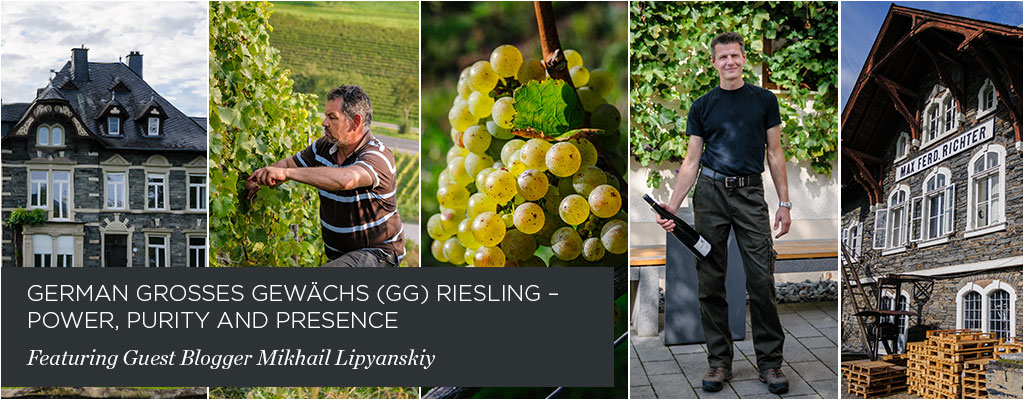
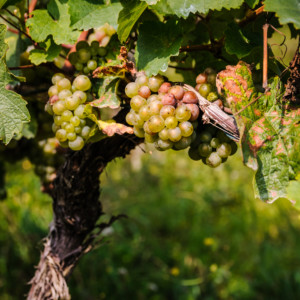 began with Riesling as well, with a Mosel Kabinett in fact, a 2001 Max Ferdinand Richter Wehlener Sonnenuhr Riesling Kabinett. And here begins the difficulty of deciphering German labels for many wine lovers – what do all those words mean?
began with Riesling as well, with a Mosel Kabinett in fact, a 2001 Max Ferdinand Richter Wehlener Sonnenuhr Riesling Kabinett. And here begins the difficulty of deciphering German labels for many wine lovers – what do all those words mean?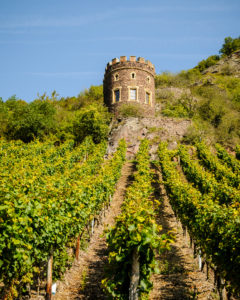 with the evolution of winemaking techniques and the ability to create stable wines at any sweetness level. What was German Riesling like before that? Well, that depends… on where, and when. Without modern methods, wine stopped fermentation when it was “ready”. That depended on the yeast strain, on the weather and on the harvest – thus the wines were not uniform.
with the evolution of winemaking techniques and the ability to create stable wines at any sweetness level. What was German Riesling like before that? Well, that depends… on where, and when. Without modern methods, wine stopped fermentation when it was “ready”. That depended on the yeast strain, on the weather and on the harvest – thus the wines were not uniform.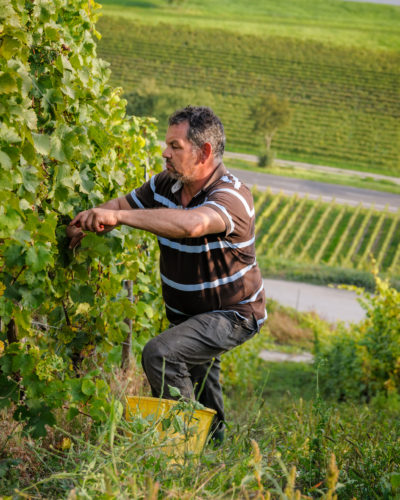 Where did the “Grosses Gewächs” come from? The term itself refers to “Great Growths”, thus echoing both Bordeaux and Burgundy in the reference. However, its main focus is on the terroir – on the vineyard itself and the specific expression of the vineyard through a dry wine (up to 9 grams of RS – less than one percent), made of late harvest (Spätlese) grapes. Why did the wines “need” to be dry? This is a multi-layered question. The glut of low quality sweet Rieslings that existed in the marketplace, combined with the lower prices on German wines overall, lead to a perception that identified the off-dry style with lower quality. This was further complicated by the Prädikat system, which assigned value to the ripeness level of the harvested grapes and thus presented the noble-sweet wines like Auslese and Beerenauslese as the pinnacle of vineyard expression.
Where did the “Grosses Gewächs” come from? The term itself refers to “Great Growths”, thus echoing both Bordeaux and Burgundy in the reference. However, its main focus is on the terroir – on the vineyard itself and the specific expression of the vineyard through a dry wine (up to 9 grams of RS – less than one percent), made of late harvest (Spätlese) grapes. Why did the wines “need” to be dry? This is a multi-layered question. The glut of low quality sweet Rieslings that existed in the marketplace, combined with the lower prices on German wines overall, lead to a perception that identified the off-dry style with lower quality. This was further complicated by the Prädikat system, which assigned value to the ripeness level of the harvested grapes and thus presented the noble-sweet wines like Auslese and Beerenauslese as the pinnacle of vineyard expression.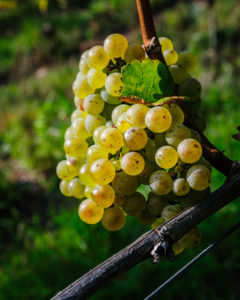 already being made by prominent estates and winemakers. Moreover, as far as Riesling was concerned, both the Austrian Smaragd wines of Wachau and the Grand Cru wines of Alsace have long proven Riesling to be an excellent grape for muscular, dry wines. The question of terroir remained – would these wines be able to show their terroir as well as the off-dry wines did? Will they feel “polished” or “unnatural”?
already being made by prominent estates and winemakers. Moreover, as far as Riesling was concerned, both the Austrian Smaragd wines of Wachau and the Grand Cru wines of Alsace have long proven Riesling to be an excellent grape for muscular, dry wines. The question of terroir remained – would these wines be able to show their terroir as well as the off-dry wines did? Will they feel “polished” or “unnatural”?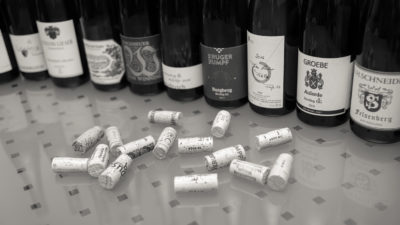 My own interest in the dry wines began to grow with the 2012 vintage. That was the first time I tasted through a lineup of German wines where the dry/GG wines were as impressive, to my palate, as the off-dry ones. Since then, I have been slowly working on understanding these wines, and how they age. I am still an advocate for the lower alcohol in dry Rieslings, and was glad to see that many of the current releases fit that profile. I was starting to buy and drink more dry wines from the Nahe and Rheinhessen. Yet, Mosel was still the home of off-dry wines for me. Revelation came during the trip to Germany, when I was able to spend 10 days in the Mosel and Saar (and a day in the Nahe). We tasted through many dry wines, much more than I expected, and I was impressed by their lightness, freshness and sheer drinkability. They no longer felt like a compromise to me, they didn’t feel “forced”.
My own interest in the dry wines began to grow with the 2012 vintage. That was the first time I tasted through a lineup of German wines where the dry/GG wines were as impressive, to my palate, as the off-dry ones. Since then, I have been slowly working on understanding these wines, and how they age. I am still an advocate for the lower alcohol in dry Rieslings, and was glad to see that many of the current releases fit that profile. I was starting to buy and drink more dry wines from the Nahe and Rheinhessen. Yet, Mosel was still the home of off-dry wines for me. Revelation came during the trip to Germany, when I was able to spend 10 days in the Mosel and Saar (and a day in the Nahe). We tasted through many dry wines, much more than I expected, and I was impressed by their lightness, freshness and sheer drinkability. They no longer felt like a compromise to me, they didn’t feel “forced”.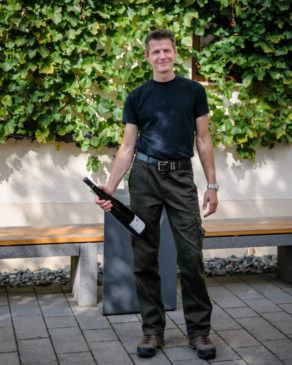 As we tasted through the dry side of the lineup, with lighter, “simpler” trocken wines first, and then the “bigger” GG – I began to see the progression and the terroir appear in the glass. That was especially true for me with the Dönnhoff Niederhäuser Hermannshöhle wines. It was always my favorite of their vineyards – especially for the rich and powerful Spätlese and Auslese wines. To think that there will be even less of those wines made felt almost like a betrayal… However, the 2016 Niederhäuser Hermannshöhle GG showed its class and power. There was no denying it; this dry wine was just as much a Hermannshöhle as its sweeter siblings. I was already a fan of the dry wines of Emrich-Schönleber. Frank’s masterful Halenberg GG is always a stunning wine. In fact, the 2005 Emrich-Schönleber Spätlese Trocken from Halenberg was one of the first dry German wines to make me really think about the category. But that wine was still very young. Here, in Nahe, Frank opened a 2007 GG for us, as a comparison point (almost a decade in the bottle at that moment). It was a beauty – still youthful (one worry alleviated) and yet showing more of that beautiful fruit and the hints of development bringing out the classic Riesling tones that feel sometimes hidden in young dry wines under the brash power of grapefruit notes.
As we tasted through the dry side of the lineup, with lighter, “simpler” trocken wines first, and then the “bigger” GG – I began to see the progression and the terroir appear in the glass. That was especially true for me with the Dönnhoff Niederhäuser Hermannshöhle wines. It was always my favorite of their vineyards – especially for the rich and powerful Spätlese and Auslese wines. To think that there will be even less of those wines made felt almost like a betrayal… However, the 2016 Niederhäuser Hermannshöhle GG showed its class and power. There was no denying it; this dry wine was just as much a Hermannshöhle as its sweeter siblings. I was already a fan of the dry wines of Emrich-Schönleber. Frank’s masterful Halenberg GG is always a stunning wine. In fact, the 2005 Emrich-Schönleber Spätlese Trocken from Halenberg was one of the first dry German wines to make me really think about the category. But that wine was still very young. Here, in Nahe, Frank opened a 2007 GG for us, as a comparison point (almost a decade in the bottle at that moment). It was a beauty – still youthful (one worry alleviated) and yet showing more of that beautiful fruit and the hints of development bringing out the classic Riesling tones that feel sometimes hidden in young dry wines under the brash power of grapefruit notes.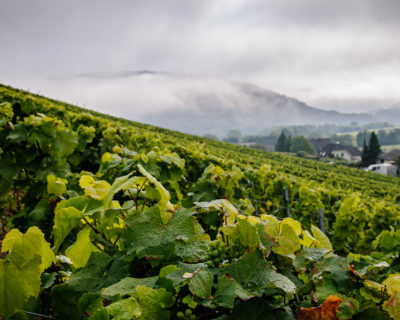 As I have mentioned, I was prepared for the dry wines of Nahe, but once we entered Saar and Mosel, it was a different story. A quick aside, we tasted mainly wines from the 2016 vintage, but it was hard not to fall in love with the elegance of the wines. Perhaps more ethereal and restrained than the brash 2015, the gentler acidity of 2016 lent itself well to the dry style. But, of course, generalization about vintages are always problematic. In Saar, Ruwer and the Mosel, I expected to love the sweeter wines and, perhaps, be intrigued by the dry. Instead, I ended up falling completely in love with the Feinherb style, and, truly impressed by the GG wines and trockens in general.
As I have mentioned, I was prepared for the dry wines of Nahe, but once we entered Saar and Mosel, it was a different story. A quick aside, we tasted mainly wines from the 2016 vintage, but it was hard not to fall in love with the elegance of the wines. Perhaps more ethereal and restrained than the brash 2015, the gentler acidity of 2016 lent itself well to the dry style. But, of course, generalization about vintages are always problematic. In Saar, Ruwer and the Mosel, I expected to love the sweeter wines and, perhaps, be intrigued by the dry. Instead, I ended up falling completely in love with the Feinherb style, and, truly impressed by the GG wines and trockens in general.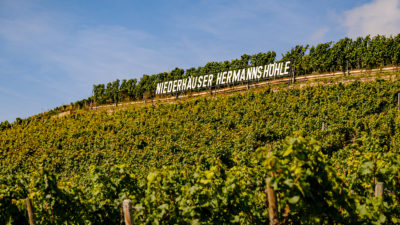 and even a few from Franken. I cannot fathom placing them into one singular description that would be of any use. When one speaks of Loire Chenin or White Burgundy – is it really a helpful definition? On the other hand, I think the GG style does offer some clarity – and there lies perhaps its biggest asset. While there may be other wines that can and do deliver the same type of product, when you pick out a GG Riesling from a shelf or a restaurant list – you can expect a serious dry wine, made from some of the best fruit and vineyards that the region has to offer. And that, I must say, is a very good start. I don’t mean to state that this is the “right” style, or the “wrong” for that matter… nor, and more importantly, the “only” style high-end German Riesling should come in. That is not for me to articulate here. Nevertheless, if one is seeking a high quality dry German Riesling – then GG wines are a great place to look.
and even a few from Franken. I cannot fathom placing them into one singular description that would be of any use. When one speaks of Loire Chenin or White Burgundy – is it really a helpful definition? On the other hand, I think the GG style does offer some clarity – and there lies perhaps its biggest asset. While there may be other wines that can and do deliver the same type of product, when you pick out a GG Riesling from a shelf or a restaurant list – you can expect a serious dry wine, made from some of the best fruit and vineyards that the region has to offer. And that, I must say, is a very good start. I don’t mean to state that this is the “right” style, or the “wrong” for that matter… nor, and more importantly, the “only” style high-end German Riesling should come in. That is not for me to articulate here. Nevertheless, if one is seeking a high quality dry German Riesling – then GG wines are a great place to look..jpg) Mosel, a steep, blue and grey slate site with a concave south facing slope. This wines from this vineyard are always evocative of Mosel and I was glad to see this GG do the same. It opens with an intense nose of crushed rock, mineral, big ripe peach and pear as well as key lime and floral notes. The palate is just as intense and juicy, with loads of mineral, bright orchard fruit (more white peach toward the back), leading to a very long, savory and mineral finish. There is a great balance of power and fruit in this wine. Still quite young, it should really come together with a bit more age. I will be putting a few of these away. (94 pts.)
Mosel, a steep, blue and grey slate site with a concave south facing slope. This wines from this vineyard are always evocative of Mosel and I was glad to see this GG do the same. It opens with an intense nose of crushed rock, mineral, big ripe peach and pear as well as key lime and floral notes. The palate is just as intense and juicy, with loads of mineral, bright orchard fruit (more white peach toward the back), leading to a very long, savory and mineral finish. There is a great balance of power and fruit in this wine. Still quite young, it should really come together with a bit more age. I will be putting a few of these away. (94 pts.).jpg) 2011 Karthäuserhof Eitelsbacher Karthäuserhofberg Riesling Großes Gewächs: This is a fairly large, south facing, Monopole vineyard near the Ruwer river, with history going back to the 14th century. I was lucky enough to get three vintages of this wine to taste. It is always fascinating to watch the evolution of Riesling, and getting a chance to try one with age along with the new releases adds a level of nuance to one’s own perceptions. This wine was tasted from a .375; at 8 years of age, it is showing development and hints of maturity. The apple and pear notes are underlined with a hint of marzipan on the nose. The palate is lovely, bright with pear and peach notes, perhaps a bit more creamy than expected and the touch of almond brings brightness to the back palate. An intriguing example of a more mature GG, with the secondary notes curb the fruit and provide a darker, more brooding experience. The wine continued to evolve in the glass, the bright acidity showing more mineral at one moment, and more texture in the next. The savory herbs added to depth – and showed really well with food. I would not hesitate to open this now, and I could see it pairing well with a wide range of dishes, from bright salads and briny appetizers, to pork and chicken. (91 pts.)
2011 Karthäuserhof Eitelsbacher Karthäuserhofberg Riesling Großes Gewächs: This is a fairly large, south facing, Monopole vineyard near the Ruwer river, with history going back to the 14th century. I was lucky enough to get three vintages of this wine to taste. It is always fascinating to watch the evolution of Riesling, and getting a chance to try one with age along with the new releases adds a level of nuance to one’s own perceptions. This wine was tasted from a .375; at 8 years of age, it is showing development and hints of maturity. The apple and pear notes are underlined with a hint of marzipan on the nose. The palate is lovely, bright with pear and peach notes, perhaps a bit more creamy than expected and the touch of almond brings brightness to the back palate. An intriguing example of a more mature GG, with the secondary notes curb the fruit and provide a darker, more brooding experience. The wine continued to evolve in the glass, the bright acidity showing more mineral at one moment, and more texture in the next. The savory herbs added to depth – and showed really well with food. I would not hesitate to open this now, and I could see it pairing well with a wide range of dishes, from bright salads and briny appetizers, to pork and chicken. (91 pts.).jpg) rest of the vineyard, which cradles the sharp bend of the Mosel River across from Pünderich. The wine opens with an earthy note of herb and savory spices. One of more backward of the wines, showing notes of dry mango, orange peel (perhaps hinting at skin contact) and guava. On the palate, the wine is broad but more directly Riesling-like, with peach and pear notes on the mid palate. The 2016s are elegant, if a hint softer for that and this wine shows it in spades. The wine becomes more tropical toward the back, but with more savory and herbal notes. The acidity is there, but playing second fiddle to the broader herb and spicy notes. The finish is warm, with a juicy peach note along with the herb and red pepper flake. This needs time – to let the herbal notes and the peach come to terms with each other. (91 pts.)
rest of the vineyard, which cradles the sharp bend of the Mosel River across from Pünderich. The wine opens with an earthy note of herb and savory spices. One of more backward of the wines, showing notes of dry mango, orange peel (perhaps hinting at skin contact) and guava. On the palate, the wine is broad but more directly Riesling-like, with peach and pear notes on the mid palate. The 2016s are elegant, if a hint softer for that and this wine shows it in spades. The wine becomes more tropical toward the back, but with more savory and herbal notes. The acidity is there, but playing second fiddle to the broader herb and spicy notes. The finish is warm, with a juicy peach note along with the herb and red pepper flake. This needs time – to let the herbal notes and the peach come to terms with each other. (91 pts.).jpg) 2016 Dönnhoff Niederhäuser Hermannshohle Riesling Großes Gewächs: (tasted in Germany, at the estate) A beautiful, steep vineyard that hugs the Nahe River across from Oberhausen an der Nahe. The soils here are blue-grey slate with clay and limestone. The nose is highly floral, with notes of white and yellow flowers, peach and pear. Palate shows powerful acidity, mouth watering and bright. Chewy, thick mid with complex notes of fruit and ginger (candied). Young but already excellent – and will age marvelously. (94 pts.)
2016 Dönnhoff Niederhäuser Hermannshohle Riesling Großes Gewächs: (tasted in Germany, at the estate) A beautiful, steep vineyard that hugs the Nahe River across from Oberhausen an der Nahe. The soils here are blue-grey slate with clay and limestone. The nose is highly floral, with notes of white and yellow flowers, peach and pear. Palate shows powerful acidity, mouth watering and bright. Chewy, thick mid with complex notes of fruit and ginger (candied). Young but already excellent – and will age marvelously. (94 pts.).jpg) Layen) which explains the name (castle mountain). The soils are iron-rich loam with quartzite and pebble. On the nose the wine shows the softer, yellow flowers and peach of Nahe fruit, this was an immediate favorite. Mineral is there as well, with hints of smoke and slate. Very elegant on the nose, even demure. The palate is just as elegant, but in a sleeker, sexier form, bright and juicy peach, stone, pineapple and grapefruit seemingly dancing a jig on the palate. The front begins like the nose, yellow peach, floral and soft but then, by the mid, the energetic tropical fruit set the tone. By the back palate, the stone, orchard and tropical fruit are singing in unison. The finish is tart, with lemon peel and sage. If one had to nitpick, the acidity felt a hint lower than on some of the other wines… but this is spectacular and drinking well right now – I would not hesitate opening it soon. (93 pts.)
Layen) which explains the name (castle mountain). The soils are iron-rich loam with quartzite and pebble. On the nose the wine shows the softer, yellow flowers and peach of Nahe fruit, this was an immediate favorite. Mineral is there as well, with hints of smoke and slate. Very elegant on the nose, even demure. The palate is just as elegant, but in a sleeker, sexier form, bright and juicy peach, stone, pineapple and grapefruit seemingly dancing a jig on the palate. The front begins like the nose, yellow peach, floral and soft but then, by the mid, the energetic tropical fruit set the tone. By the back palate, the stone, orchard and tropical fruit are singing in unison. The finish is tart, with lemon peel and sage. If one had to nitpick, the acidity felt a hint lower than on some of the other wines… but this is spectacular and drinking well right now – I would not hesitate opening it soon. (93 pts.)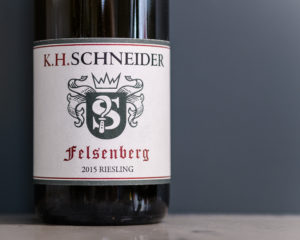 2015 K.H. Schneider Schloßböckelheimer Felsenberg Riesling trocken: While this is not officially a GG wine, I really wanted to have something in the lineup from this stunning volcanic vineyard. The wine opens with sleek, yellow peach, hint of smoke, tropical notes (pineapple); with time it becomes more mineral, showing less sweet notes and more crushed stone, a hint of spice. On the palate it is quite dry but not at all austere. Pineapple, lemon peel, hint of grapefruit pith drive the fruit profile. Bright acidity on the front of the palate brings to a slightly softer, tropical mid palate (softened by the sweet citrus) and then on to a mineral, bright yellow grapefruit and a pithy, zesty finish. The overall impression of the wine is elegant and balanced, leaning more toward the graperfruit/citrus side of the scale rather than the stone fruit. With more time, it began to really show itself as a true example of Nahe – the combination of elegant yellow fruit, spice and smoke. (92 pts.)
2015 K.H. Schneider Schloßböckelheimer Felsenberg Riesling trocken: While this is not officially a GG wine, I really wanted to have something in the lineup from this stunning volcanic vineyard. The wine opens with sleek, yellow peach, hint of smoke, tropical notes (pineapple); with time it becomes more mineral, showing less sweet notes and more crushed stone, a hint of spice. On the palate it is quite dry but not at all austere. Pineapple, lemon peel, hint of grapefruit pith drive the fruit profile. Bright acidity on the front of the palate brings to a slightly softer, tropical mid palate (softened by the sweet citrus) and then on to a mineral, bright yellow grapefruit and a pithy, zesty finish. The overall impression of the wine is elegant and balanced, leaning more toward the graperfruit/citrus side of the scale rather than the stone fruit. With more time, it began to really show itself as a true example of Nahe – the combination of elegant yellow fruit, spice and smoke. (92 pts.)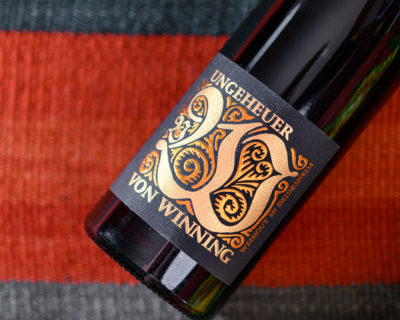 2017 von Winning Forster Ungeheuer Riesling Großes Gewächs: Von Winning wines are definitely unusual – with a clear note of oak influence. However, if given the chance, show a different aspect of Riesling. This particular wine comes from a rich vineyard of sandy clay and shows the broader, richer side of Pfalz. The nose is impressively powerful, with yellow peach with a hint of toast and cider apples. While the vanilla and white flowers add nuance, the dominant note is of stone fruit. I was surprised how well integrated the wine was showing, having had it previously several months ago. The palate has a more prominent note of oak, with its roundness and the candied peach on the front. The mid is unctuous, if one may use the word for a “dry” wine, with mango and pink grapefruit notes. This is surely a full bodied example, but it is underscored by great acidity. The finish adds grassy and herbal notes to the party, restoring the freshness and juicyness to the wine. Perhaps a touch front-heavy at this stage, but it is a very young wine and built for age. (92 pts.)
2017 von Winning Forster Ungeheuer Riesling Großes Gewächs: Von Winning wines are definitely unusual – with a clear note of oak influence. However, if given the chance, show a different aspect of Riesling. This particular wine comes from a rich vineyard of sandy clay and shows the broader, richer side of Pfalz. The nose is impressively powerful, with yellow peach with a hint of toast and cider apples. While the vanilla and white flowers add nuance, the dominant note is of stone fruit. I was surprised how well integrated the wine was showing, having had it previously several months ago. The palate has a more prominent note of oak, with its roundness and the candied peach on the front. The mid is unctuous, if one may use the word for a “dry” wine, with mango and pink grapefruit notes. This is surely a full bodied example, but it is underscored by great acidity. The finish adds grassy and herbal notes to the party, restoring the freshness and juicyness to the wine. Perhaps a touch front-heavy at this stage, but it is a very young wine and built for age. (92 pts.).jpg) impressively steep, with slopes reaching a gradient of 100%! Gunderlock dry wines have been spectacular for a long time, and this fits right into that legacy. The ’15 is in a good place now, with rich lemon custard on the nose, but a juicy, fresh palate of mineral, savory herb and citrus. Broad mid palate offers power along with the mineral notes leading to a long and tart finish of lemon and orange zest. With time, the wines shows more tangy peach and yellow grapefruit. (92 pts.)
impressively steep, with slopes reaching a gradient of 100%! Gunderlock dry wines have been spectacular for a long time, and this fits right into that legacy. The ’15 is in a good place now, with rich lemon custard on the nose, but a juicy, fresh palate of mineral, savory herb and citrus. Broad mid palate offers power along with the mineral notes leading to a long and tart finish of lemon and orange zest. With time, the wines shows more tangy peach and yellow grapefruit. (92 pts.)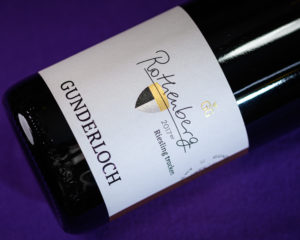 2017 Gunderloch Nackenheim Rothenberg Riesling Großes Gewächs: Like the Pettenthal above, this is a red soil vineyard, though even steeper and with less topsoil. This wine is in serious need of time – it showed a lot better after a few days, but was still quite backward. Nose of Mayer lemon and vanilla, still a clear hint of oak influence. The palate is ripe, with a tropical core, juicy and showing good mineral and saline component. Showing incredibly young but should improve with more age. (91 pts.)
2017 Gunderloch Nackenheim Rothenberg Riesling Großes Gewächs: Like the Pettenthal above, this is a red soil vineyard, though even steeper and with less topsoil. This wine is in serious need of time – it showed a lot better after a few days, but was still quite backward. Nose of Mayer lemon and vanilla, still a clear hint of oak influence. The palate is ripe, with a tropical core, juicy and showing good mineral and saline component. Showing incredibly young but should improve with more age. (91 pts.)